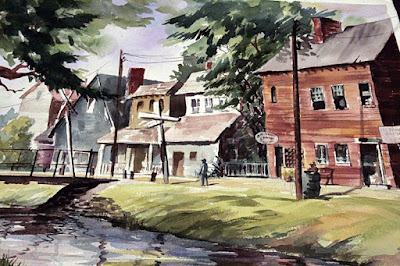Homework for November 16th
1.
How is
nature viewed differently between the Gussucks and the native people, and how
does Silko portray these differences?
2. What role does color play in the story?
3. The story opens with the sun in “the center of the sky.” By the end of the story,
“the sun had finally broken loose from the ice.” What significance do you see
the movement of the sun playing in the story and what does the sun symbolize?
4. How does Silko portray the relationship between the Gussucks and the native people?


In “Storyteller,” Silko appears to use the movement and position of the sun as a symbol of the cosmic power of the world. In the first scene, the sun “was frozen, caught in the middle of the sky… heavy frost would begin to appear on the edges and spread across the face of the sun like a mask” (17). Here, the sun symbolizes the cosmic injustice that white encroachment have wrought on nature and the native people. As the sun is the source of light, warmth, and life, the imagery of it becoming “frozen” reveals how white encroachment (the “heavy frost” creeping over it is literally white like the Gussacks) in the forms of “portable buildings…. barges... squares of metal… cars… oil hardened and moving parts” (17) are interrupting the cycle of nature (we also see this in the visual way that descriptions of Gussack inventions interrupt that of the skies). Similarly, the frost covering the sun in a white mask reflects “what the Gussack school would do” to the native children, aka forced assimilation into white society by making them forget their native identity and traditions (19). In a Native American literature course that I took last semester, we discussed how Native Americans highly valued the ways nature, human beings, and the cosmos should live in harmony with each other as equals, and the Gussacks’ disruption of that harmony therefore represents a cosmic injustice.
ResponderExcluirThus, the fact that “the sun had finally broken loose from the ice” at the end of the story represents a restoration of cosmic justice to an extent. This seems to have been accomplished by the way that the Eskimo woman got revenge on the Gussack storekeeper for the poisoning of her parents, as she led him to the same fate by leading him fall into the ice. The woman also refuses to lie about the murder she committed, for she knows that she must accept responsibility for her own actions to ensure balance, a cosmic justice. However, the sun’s “light was weak and pale; it pushed dimly through the clouds” (30). The sun’s continuing weakness reflects the way that, in spite of the Eskimo woman’s actions, the native people and nature still remain victim to the Gussack’s encroachment. Yet it continues to try to survive, and it does so through the telling and passing down of stories. The young woman continues to tell the Eskimo story of the blue bear “year after year as the old man had done, without lapse or silence” (30). The story is representative of one kind of Native tradition, belief, and presence, so as Silko once said herself, “Language forces meaning into existence… we begin to feel an intimacy and immediacy of that long ago moment,” meaning that storytelling allows for Native history, traditions, and myth to survive, to work towards a greater cosmic justice.
In “Storyteller”, Leslie Marmon Silko uses the different ways the native people and the Gussucks view the cold to demonstrate that the Gussucks view nature as an obstacle and a resource that can be manipulated while the Eskimos consider it an immutable, divine force to be respected. Although the Gussucks are not suited to the frigid climate, they repeatedly come to the village to take advantage of its natural qualities. As the old man said, “They only come when there is something to steal. The fur animals are too difficult for them to get now, and the seals and fish are hard to find. Now they come for oil deep in the earth.” (Silko,21) they are clearly out of their element in the region as they cannot fish or find fur animals, nevertheless, their greed for oil motivates them to keep coming back to the tundra. Additionally, the white people in the story believe that the cold is a barrier that can be overcome, showing their naiveté and their arrogance. “They thought they could keep out the cold with string yellow waddling. Look at the sun. It wasn’t moving; it was frozen, caught in the middle of the sky.” (Silko, 17) From the narrator’s perspective, the Gussucks are extremely foolish to think that the cold could be kept out by yellow foam. This is made even more ridiculous and arrogant considering that the cold is powerful enough to stop the sun. The native people hold no such presumptions about the cold; however, accepting that it is more powerful than they are. The old man is especially conscious of this, stating, “in the wintertime the two of us are no different from those dogs. We wait in the cold for someone to bring us a few dry fish.” (Silko, 20). To the native people, nature, and the cold specifically, is not an element that should be experimented with, but rather an all-powerful force that equalizes men and dogs. Later in the story, Silko further illustrates the Eskimo’s reverence for nature through the old man. “It is approaching. As it comes, ice will push across the sky… It began with a giant bear which he described muscle by muscle, from the curve of the ivory claws to the whorls of hair at the top of the massive skull.”( Silko, 21) The old man takes respect for nature a step further, describing the imminent winter as a majestic bear.
ResponderExcluir-Shrenik
In Sillko’s short story “Storyteller”, the use of color is used to clearly emphasize the emotional effect and opinion the girl has on her surroundings, including people. In the opening paragraph, Sillko writes “The color of the sky had not been good lately; it had been pale blue, almost white… she told herself it wasn’t a good sign for the sky to be indistinguishable from the river ice” (17). The color white is often paired with negative objects within the story; the white ice, the cold snow, and most importantly, white people, the Gussacks. Whiteness and paleness, common features of the Gussacks, are compared to the bleak sky, allowing Sillko to reinforce the animosity and negative attitudes held by the girl and her fellow Eskimo towards those groups. In contrast, the color red symbolizes the home, and comfort. This distinction defies common convention to some degree; White is typically used to personify purity and peace, whereas the color red may hold more negative connotations. “Storyteller” is unique in that red is used to invoke emotions associated with the home, as evidenced by the red roofs of the village. Later on in the story, this association is presented, with Sillko writing, “But then, in the distance, she saw something red, and suddenly it was as she had remembered it all those years” (28). Earlier, the author makes note of the red shoes worn by the girl. Overall, the use of color is very prevalent, and almost all descriptions of items include something of the color. Sillko’s objective could be to illustrate the contrast of the brutal northern landscape, but it could also be to highlight the contrasting cultures; the “white” Gussacks and red Eskimos. Much like the War of the Roses in medieval England, colors can create a sense of association, but also feelings of animosity. The role of colors in “Storyteller” is consistent the story and they serve as identifiers for both the reader and the characters.
ResponderExcluir
ResponderExcluirSilko’s “Storyteller” is a commentary on the exploitative nature of the relationship between the white Gussucks and Native Eskimos of a small Yupik community. Rather than attending a Gussuck school and undergoing assimilation, the narrator makes the difficult choice to live instead with an elderly Native man “whose hands were always hunting...ready to touch her” (19). Gussuck and Native men alike were not hesitant to pursue sexual relationships with young Native girls, resulting in rampant sexual abuse. Using this to her advantage, the narrator seduces a Gussuck storeman. She later provokes him, purposely leading the storeman on a chase through the unforgiving cold of her people’s land. Throughout the story, the old man continually speaks of the coming of a “giant bear whose color was pale blue glacier ice” (21). He foreshadows the arrival of a higher power, coming to restore balance.
The storeman cannot grasp the full force of nature, but the young girl knows this and allows him to continue chasing her, even as the ice beneath them grows thinner and finally cracks, drowning him. It is significant to note that the storeman had caused the deaths of her parents several years prior, when they were poisoned by some alcohol from his store. The manner of his death is reflective of the Gussucks’ foolish view of nature and the impermanence of their lifestyle; in the end, nature overpowers all.
The young girl also readily admits to killing the man when prompted by police, although it was easily argued that he died of his own accord. She chooses to protect her integrity and tell the “true story,” fulfilling the wishes of her grandmother. To the Gussucks, Native lives were easily disposable, and the storeman’s lack of blame in the death of her parents is an indicator of the superiority Gussucks had over the Native populace. They were selfish and unwilling to confront the effects of their drilling and hunting as well. The consequences of their continued exploitation of the landscape is seen only by the Natives. The storeman’s death was not merely the avenging of a crime; it was the triumph of nature over man. By confessing to her deed, the narrator achieves both liberation and closure.